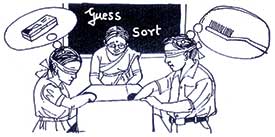Sorting, sensing, guessing!
Actual education can begin only after the child has already acquired the necessary basics. Reading and writing are preceded by recognizing, understanding and connecting. Teacher Plus suggests a few pre-reading and pre-learning activities to help prepare a child for the education which is to follow soon.
Play is an activity that every child enjoys from his earliest days. More importantly, it is also the most effective method of learning. The concept of the early childhood years being the most powerful years for building the foundation of human intelligence is fast gaining due recognition. Through play a child learns to concentrate, develop imaginative skills, trial and error techniques, imitation and coming to terms with the world at large.
The insatiable sense of curiosity with which a child is endowed helps him/her in this process of learning. The activities provided in this article help the teacher initiate the learning process in a child through play before the actual education begins. The activities are aimed at children of pre-primary and early primary.
Activity 1: Our senses (sight, hearing, touch, taste and smell) are our first informers of the world. The quantity and quality of one’s sensory experiences determine the development of his perceptions, vocabulary growth and creative instincts. In the present activity we concentrate on the sense of touch. The child is expected to be able to recognize things merely by feeling them.
Materials required for this activity:
A large cardboard box – to be later sealed by a tape on all sides with 4-inch by 4-inch holes on two opposite sides.
Assorted small objects of various textures: spoon, plastic cup, stone, sponge, straw, crayon, silk scarf, small toy, socks etc.
Activity: Place the assorted objects in the box and seal it.
Place the box on the teacher’s table – the holes enable the child to only feel the objects with their hands and not see them.
Let the students come by turns and feel one object and identify it. After doing so, pull out the object to check his response. Alternatively, the students can be blindfolded.
 Activity 2: Before a child is initiated into the actual process of reading, certain skills that provide a foundation for learning to read have to be inculcated. The child needs to first realize that words stand for real things. From the following activity, the child learns to use picture clues and context clues to guess the whole picture or recognize a picture from various angles. This lays the foundation for making intelligent guesses while reading and to understand different points of view.
Activity 2: Before a child is initiated into the actual process of reading, certain skills that provide a foundation for learning to read have to be inculcated. The child needs to first realize that words stand for real things. From the following activity, the child learns to use picture clues and context clues to guess the whole picture or recognize a picture from various angles. This lays the foundation for making intelligent guesses while reading and to understand different points of view.
Materials required for this activity:
Pictures of different things – trucks, cars, animals etc.
A sliding screen (manually operated will do) to cover the picture and reveal it bit by bit.
Activity: Place the picture against a wall or the blackboard so that it faces the students.
Immediately place the screen over it so pupils can’t see the picture.
Slide the screen depending on how you wish to reveal the picture.
Encourage the students (single/group) to guess/recognize the picture in the earliest stages of unveiling.
A slight variation of this activity could be to present a picture of an item from different angles other than the normal angle and encourage the students to guess what it represents. For example, a picture of a table taken from the ceiling, wherein only the table-top is seen and the article kept over it(as seen from above). This too serves the same purpose.
Activity 3: Classifying and organizing is one of the very important lessons a child needs to learn. This knowledge provides the necessary foundation for an easier and more organized life. For this, a child has to first learn the concepts of ‘sameness’ and ‘difference’. Eventually it instills the quality of logical thought in a child.
Materials required for the activity:
A large jar with a wide mouth.
An egg carton or several smaller boxes to help in sorting.
A number of different items (similar yet different in size, shape, colour etc.). For example, screws or bolts and nuts of different sizes and shapes.
Activity: Fill the jar with all the objects.
Encourage the students (in groups) to classify and sort them into different compartments.
A variation of this activity is to use old, tiny objects around the house like buttons, coins, hairpins, paper clips etc. for sorting.
This article first appeared in Teacher Plus, May-June 1998, Vol. No.: 54.
